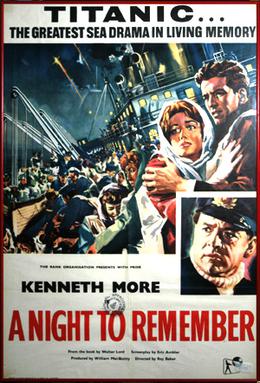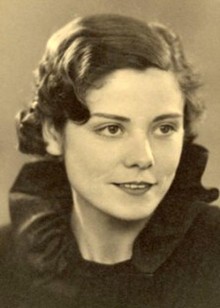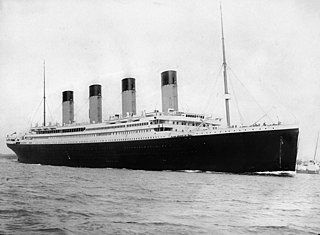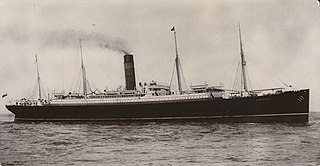
Harold Sydney Bride was a British merchant seaman and the junior wireless officer on the ocean liner RMS Titanic during her ill-fated maiden voyage.

William McMaster Murdoch, RNR was a Scottish sailor who served as a Lieutenant in the Royal Navy Reserve and was the first officer on the RMS Titanic. He was the officer in charge on the bridge when the Titanic collided with an iceberg, and was amongst the 1,500 people who died when the ship sank. The circumstances of his death have been the subject of controversy.

S.O.S. Titanic is a 1979 drama disaster television movie that depicts the doomed 1912 maiden voyage from the perspective of three distinct groups of passengers in first, second and third class. The script was written by James Costigan and directed by William Hale. It is the first Titanic film to be filmed and released in colour.

Sir Arthur Henry Rostron, KBE, RD was a British merchant seaman and a seagoing officer for the Cunard Line. He is best known as the captain of the ocean liner RMS Carpathia, when it rescued the survivors from the RMS Titanic after the ship sank in 1912 in the middle of the North Atlantic Ocean.

Commander Harold Godfrey Lowe, RD was a Welsh naval officer. He was also the fifth officer of the RMS Titanic, and was amongst the four of the ship's officers to survive the disaster.

A Night to Remember is a 1958 British historical disaster docudrama film based on the eponymous 1955 book by Walter Lord. The film and book recount the final night of RMS Titanic, which sank on her maiden voyage after she struck an iceberg in 1912. Adapted by Eric Ambler and directed by Roy Ward Baker, the film stars Kenneth More as the ship's Second Officer Charles Lightoller and features Michael Goodliffe, Laurence Naismith, Kenneth Griffith, David McCallum and Tucker McGuire. It was filmed in the United Kingdom and tells the story of the sinking, portraying the main incidents and players in a documentary-style fashion with considerable attention to detail. The production team, supervised by producer William MacQuitty used blueprints of the ship to create authentic sets, while Fourth Officer Joseph Boxhall and ex-Cunard Commodore Harry Grattidge worked as technical advisors on the film. Its estimated budget of up to £600,000 was exceptional and made it the most expensive film ever made in Britain up to that time. The film's score was written by William Alwyn.

Harold Thomas Cottam was a British wireless operator on the RMS Carpathia who fortuitously happened to receive the distress call from the sinking RMS Titanic on 15 April 1912. Cottam's decision to awaken Captain Arthur Henry Rostron and relay Titanic's message in spite of the scepticism of the officer on watch allowed Carpathia to arrive at the scene hours before any other ship and is "credited with saving hundreds of lives." He was a personal friend of the Titanic's wireless operators Harold Bride and Jack Phillips.

Archibald Gracie IV was an American writer, soldier, amateur historian, real estate investor, and passenger aboard RMS Titanic. Gracie survived the sinking of the Titanic by climbing aboard an overturned collapsible lifeboat and wrote a popular book about the disaster. He never recovered from his ordeal and died less than eight months after the sinking, becoming the first adult survivor to die.

Barbara Joyce Dainton was the penultimate remaining survivor of the sinking of the RMS Titanic on 14 April 1912 after hitting an iceberg on its maiden voyage. She was the last living survivor who travelled second-class on the ship.

RMS Titanic sank on 15 April 1912 in the North Atlantic Ocean. The largest ocean liner in service at the time, Titanic was four days into her maiden voyage from Southampton to New York City, with an estimated 2,224 people on board when she struck an iceberg at 23:40 on 14 April. Her sinking two hours and forty minutes later at 02:20 ship's time on 15 April resulted in the deaths of more than 1,500 people, making it one of the deadliest peacetime maritime disasters in history.

Robert Williams Daniel was an American banker who survived the sinking of the RMS Titanic in 1912, and later became a gentleman farmer and served in the Virginia Senate.

A total of 2,240 people sailed on the maiden voyage of the Titanic, the second of the White Star Line's Olympic-class ocean liners, from Southampton, England, to New York City. Partway through the voyage, the ship struck an iceberg and sank in the early morning of 15 April 1912, resulting in the deaths of 1,517 passengers and crew.

RMS Carpathia was a Cunard Line transatlantic passenger steamship built by Swan Hunter & Wigham Richardson in their shipyard in Wallsend, England.
Joseph Zupicich was a crewmember on the RMS Carpathia when RMS Titanic survivors boarded the liner after being rescued on April 15, 1912 from lifeboats by the Carpathia crew.

There have been several legends and myths surrounding the RMS Titanic and its destruction after colliding with an iceberg in the Atlantic Ocean. These have ranged from stories involving the myth about the ship having been described as "unsinkable" to the myth concerning the final song played by the ship's musicians.

Titanic Lifeboat No. 1 was a lifeboat from the steamship Titanic. It was the fifth boat launched to sea, over an hour after the liner collided with an iceberg and began sinking on 14 April 1912. With a capacity of 40 people, it was launched with only 12 aboard, the fewest to escape in any one boat that night.

Lifeboats played a crucial role during the sinking of the Titanic on 14–15 April 1912. The ship had 20 lifeboats that, in total, could accommodate 1,178 people, a little over half of the 2,209 on board the night it sank.

There were many animals aboard the Titanic during her disastrous maiden voyage, which ended with the ship sinking on 15 April 1912 after colliding with an iceberg.

Marian Longstreth Thayer was an American socialite and survivor of the sinking of the RMS Titanic. She was the wife of John Borland Thayer II, a Director and Second Vice President of the Pennsylvania Railroad Company, and the mother of John Borland "Jack" Thayer III. In 1912, all three of them, along with their maid Margaret Fleming, were passengers on RMS Titanic maiden voyage when it struck an iceberg and sank. Marian, Jack III, and Fleming all survived, but John II died.

Dickinson H. Bishop was an American businessman who traveled on board the ill-fated maiden voyage of the RMS Titanic while on his honeymoon with bride Helen, née Walton. They both survived the sinking of the Titanic on 15 April 1912.